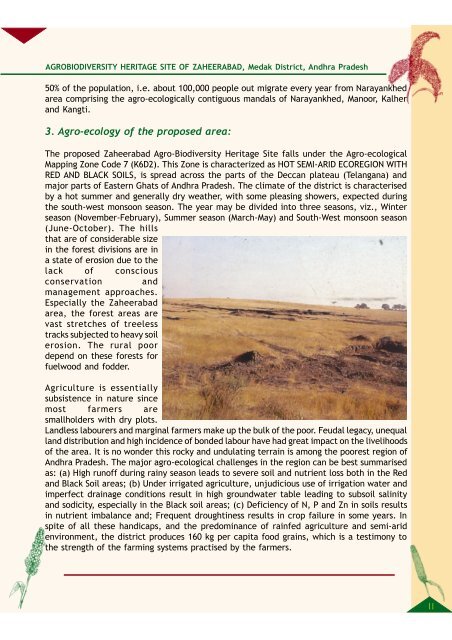Click for details - Deccan Development Society
Click for details - Deccan Development Society
Click for details - Deccan Development Society
Create successful ePaper yourself
Turn your PDF publications into a flip-book with our unique Google optimized e-Paper software.
AGROBIODIVERSITY HERITAGE SITE OF ZAHEERABAD, Medak District, Andhra Pradesh<br />
50% of the population, i.e. about 100,000 people out migrate every year from Narayankhed<br />
area comprising the agro-ecologically contiguous mandals of Narayankhed, Manoor, Kalher<br />
and Kangti.<br />
3. Agro-ecology of the proposed area:<br />
The proposed Zaheerabad Agro-Biodiversity Heritage Site falls under the Agro-ecological<br />
Mapping Zone Code 7 (K6D2). This Zone is characterized as HOT SEMI-ARID ECOREGION WITH<br />
RED AND BLACK SOILS, is spread across the parts of the <strong>Deccan</strong> plateau (Telangana) and<br />
major parts of Eastern Ghats of Andhra Pradesh. The climate of the district is characterised<br />
by a hot summer and generally dry weather, with some pleasing showers, expected during<br />
the south-west monsoon season. The year may be divided into three seasons, viz., Winter<br />
season (November-February), Summer season (March-May) and South-West monsoon season<br />
(June-October). The hills<br />
that are of considerable size<br />
in the <strong>for</strong>est divisions are in<br />
a state of erosion due to the<br />
lack of conscious<br />
conservation and<br />
management approaches.<br />
Especially the Zaheerabad<br />
area, the <strong>for</strong>est areas are<br />
vast stretches of treeless<br />
tracks subjected to heavy soil<br />
erosion. The rural poor<br />
depend on these <strong>for</strong>ests <strong>for</strong><br />
fuelwood and fodder.<br />
Agriculture is essentially<br />
subsistence in nature since<br />
most farmers are<br />
smallholders with dry plots.<br />
Landless labourers and marginal farmers make up the bulk of the poor. Feudal legacy, unequal<br />
land distribution and high incidence of bonded labour have had great impact on the livelihoods<br />
of the area. It is no wonder this rocky and undulating terrain is among the poorest region of<br />
Andhra Pradesh. The major agro-ecological challenges in the region can be best summarised<br />
as: (a) High runoff during rainy season leads to severe soil and nutrient loss both in the Red<br />
and Black Soil areas; (b) Under irrigated agriculture, unjudicious use of irrigation water and<br />
imperfect drainage conditions result in high groundwater table leading to subsoil salinity<br />
and sodicity, especially in the Black soil areas; (c) Deficiency of N, P and Zn in soils results<br />
in nutrient imbalance and; Frequent droughtiness results in crop failure in some years. In<br />
spite of all these handicaps, and the predominance of rainfed agriculture and semi-arid<br />
environment, the district produces 160 kg per capita food grains, which is a testimony to<br />
the strength of the farming systems practised by the farmers.<br />
11


